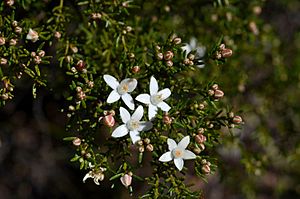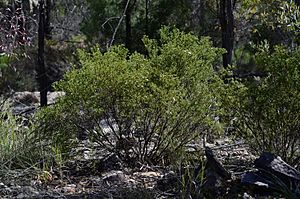Philotheca ciliata facts for kids
Quick facts for kids Philotheca ciliata |
|
|---|---|
 |
|
| In Carnarvon National Park | |
| Scientific classification | |
| Genus: |
Philotheca
|
| Species: |
ciliata
|
Philotheca ciliata is a pretty flowering plant that grows as a shrub. It belongs to the plant family called Rutaceae, which also includes citrus fruits like oranges! This plant is special because it's only found in certain parts of inland New South Wales and Queensland, Australia. It has small, thin leaves and lovely white flowers that grow at the ends of its branches.
What Does It Look Like?
Philotheca ciliata is a shrub that can grow up to about 2 meters (about 6.5 feet) tall. Its leaves are narrow and shaped like a cylinder, usually 4 to 6 millimeters long. They often have slightly hairy edges.
The flowers are white and grow either by themselves or in small groups of two or three. You'll find them at the very ends of the plant's small branches. Each flower sits on a tiny stalk, called a pedicel, which is only about 1 to 2 millimeters long.
Each flower has five small, egg-shaped sepals, which are like tiny leaves that protect the bud. These are about 1 millimeter long. It also has five narrow, white petals, each about 5 millimeters long. Inside the flower, there are ten stamens, which are the parts that make pollen. These stamens are joined together at their base and have hairs on their upper parts.
This plant usually flowers from August to November. After flowering, it produces a fruit that has little tufts of hair on its end.
How Was It Named?
The plant Philotheca ciliata was first officially described in 1848. A scientist named William Jackson Hooker wrote about it. He included its description in a book called Journal of an Expedition into the Interior of Tropical Australia. This book was written by Thomas Mitchell, who was an explorer.
Where Does It Grow?
This type of philotheca plant likes to grow in areas with woodlands and mallee (a type of shrubland). You can find it in the inland parts of south-east Queensland. In New South Wales, it grows near a town called West Wyalong and in the northern part of the Pilliga Scrub.
Is It Protected?
The Queensland Government has a list of plants and animals and how rare they are. Under their Nature Conservation Act 1992, Philotheca ciliata is listed as being of "least concern." This means it is not currently considered to be in danger of disappearing.


